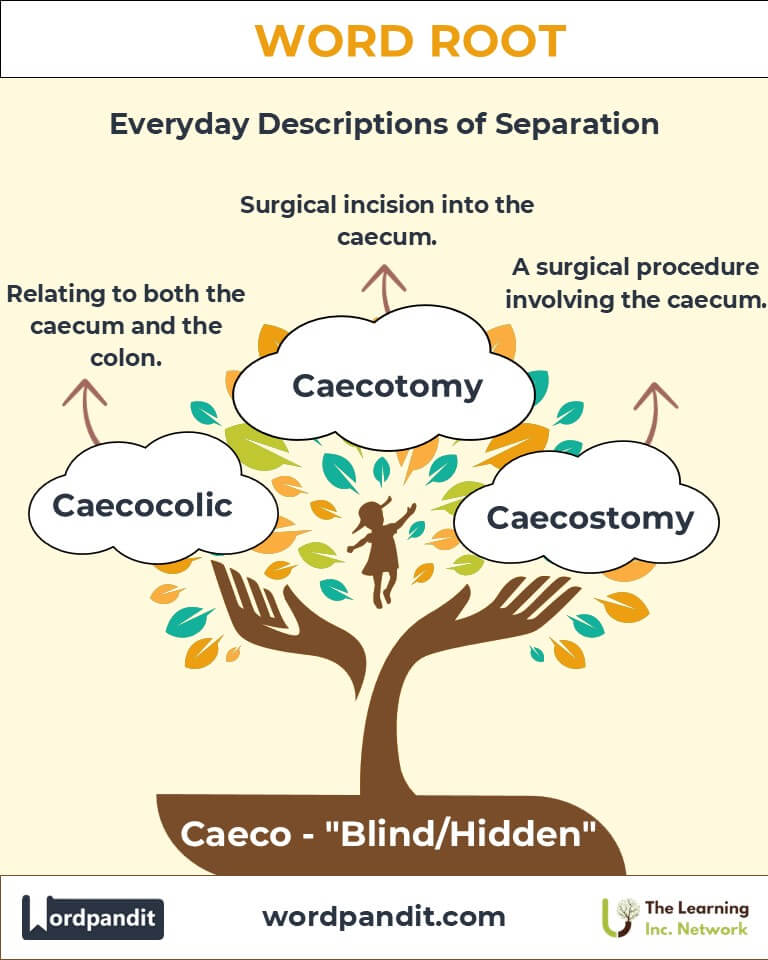Caeco: The Blind Root of Biology and Evolution
Byline: Uncover the significance of "Caeco," a root derived from Latin meaning "blind." This root forms the foundation of words like "caecum" and "caecilian," weaving its way into anatomical and zoological discussions. Explore how "Caeco" has illuminated the hidden intricacies of life sciences.

Table of Contents
- Introduction: The Mystery of "Caeco"
- Etymology and Historical Journey
- Mnemonic: Unlocking the Power of "Caeco"
- Common "Caeco"-Related Terms
- "Caeco" Through Time
- "Caeco" in Specialized Fields
- Illustrative Story: "Caeco" in Action
- Cultural Significance of "Caeco"
- The "Caeco" Family Tree
- FAQs about the "Caeco" Root
- Test Your Knowledge: "Caeco" Mastery Quiz
- Conclusion: The Legacy of "Caeco"
1. Introduction: The Mystery of "Caeco"
The word root "Caeco" (pronounced see-ko) originates from the Latin "caecus," meaning "blind" or "hidden." This seemingly paradoxical root has given rise to terms that unveil hidden structures in anatomy and the animal kingdom. From the human caecum to the legless caecilian, "Caeco" offers insight into the evolution of concealed features and their roles in biology.

2. Etymology and Historical Journey
The Latin root caecus dates back to ancient Rome, denoting blindness or obscurity. Its medical application emerged with early anatomical studies, where the caecum, a pouch-like structure in the digestive tract, was named for its "blind-ended" nature. Over centuries, the root expanded into zoological taxonomy, giving rise to the term caecilian, referring to limbless amphibians whose hidden lifestyles epitomize "blindness."
3. Mnemonic: Unlocking the Power of "Caeco"
To remember "Caeco," imagine a blindfolded explorer navigating a dark cave. The "blind" explorer reflects the hidden or obscure nature symbolized by "Caeco."
4. Common "Caeco"-Related Terms
- Caecum (see-kum):
Definition: A pouch connected to the junction of the small and large intestines, often referred to as the "blind gut."
Example: "The caecum plays a crucial role in digesting plant material in herbivores like rabbits." - Caecilian (see-sil-ee-an):
Definition: A limbless, burrowing amphibian resembling a worm or snake.
Example: "Caecilians thrive underground, their 'blind' eyes adapted to darkness." - Caecal (see-kul):
Definition: Relating to the caecum.
Example: "Inflammation of the caecal region can indicate appendicitis in humans." - Caecitis (see-kite-is):
Definition: Inflammation of the caecum.
Example: "Caecitis is a condition commonly observed in certain livestock." - Caecostomy (see-kos-tuh-mee):
Definition: A surgical procedure involving the caecum.
Example: "A caecostomy may be performed to alleviate intestinal obstruction."
5. "Caeco" Through Time
The root "Caeco" reflects humanity's quest to understand what lies hidden. Early anatomists described the caecum as a "blind sac," noting its lack of a direct outlet. In zoology, the discovery of caecilians unveiled creatures adapted to life underground, with vestigial or hidden eyes.
- Historical Insight: The caecum was once thought to have minimal function in humans, but modern science highlights its role in immune defense and gut microbiota.
- Zoological Evolution: The evolutionary adaptations of caecilians, such as sensory tentacles, illustrate how "blindness" can lead to remarkable innovation.
6. "Caeco" in Specialized Fields
- Medicine: Caecum disorders, such as appendicitis, are critical in gastrointestinal health.
- Zoology: Caecilians provide insights into evolutionary biology and adaptations to subterranean habitats.
- Surgery: Caecostomy procedures emphasize the caecum's relevance in medical innovation.
7. Illustrative Story: "Caeco" in Action
Deep in the rainforest, Dr. Lila, a herpetologist, unearthed a rare caecilian species. Despite its hidden eyes, the creature navigated flawlessly through its environment, relying on sensory tentacles. Meanwhile, at a nearby hospital, surgeons performed a life-saving caecostomy on a patient with an intestinal blockage. These parallel stories illustrate how "Caeco" connects the unseen realms of nature and medicine.
8. Cultural Significance of "Caeco"
The symbolism of blindness transcends language and culture, often representing wisdom or the unknown. "Caeco" echoes this theme, drawing attention to life's hidden systems and their profound impact on health, evolution, and ecology.
9. The "Caeco" Family Tree
Exploring related roots enhances our understanding of "Caeco":
- Oc- (Latin: "eye, vision"):
Example: Ocular (pertaining to the eyes). - Crypt- (Greek: "hidden"):
Example: Cryptic (concealed or mysterious). - Ambly- (Greek: "dim, dull"):
Example: Amblyopia (reduced vision).

10.FAQs About the Caeco Word Root
Q: What does "Caeco" mean?
A: "Caeco" originates from the Latin root caecus, meaning "blind" or "hidden." It describes structures or organisms with obscured or vestigial features, such as the caecum or caecilians.
Q: What is the caecum?
A: The caecum is a pouch-like structure at the junction of the small and large intestines. Known as a "blind gut," it ends in a cul-de-sac. In herbivores, it aids in digesting fibrous plant material.
Q: Are caecilians truly blind?
A: Caecilians are not entirely blind, but their eyes are often reduced or covered by skin, making them functionally vestigial. These adaptations suit their underground habitats.
Q: What is the role of the caecum in digestion?
A: In humans, the caecum plays a role in immune response and houses beneficial gut bacteria. In herbivores, it ferments fibrous food to extract nutrients that are otherwise indigestible.
Q: How are caecilians classified?
A: Caecilians belong to the order Gymnophiona, a group of limbless amphibians. Their name derives from the root "Caeco," referencing their hidden or vestigial eyes and burrowing lifestyle.
11.Test Your Knowledge: Caeco Word Root Quiz
1. What does the root "Caeco" signify?
2. Which term refers to a "blind-ended" pouch in the digestive system?
3. What is unique about caecilians?
4. What surgical procedure involves the caecum?
5. Which root relates to "hidden"?

12. Conclusion: The Legacy of "Caeco"
The root "Caeco" underscores the importance of exploring the unseen—whether in anatomy, zoology, or beyond. As a linguistic key to hidden wonders, it bridges the blind spots in our understanding, offering a glimpse into the intricate mechanisms of life. By studying "Caeco," we celebrate the marvels of what lies concealed yet essential.











